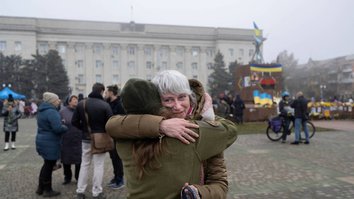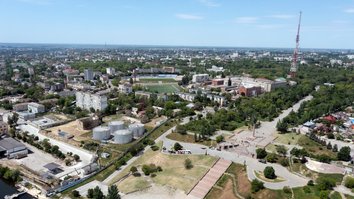KYIV -- Ukraine's partisan movement is ramping up activities in occupied areas, destroying ammunition depots, blowing up bridges, assassinating pro-Moscow officials and playing an increasingly prominent role in the war.
In recent months, several officials installed by Russian forces in Moscow-controlled parts of Ukraine have been killed or wounded in attacks.
In the latest incident, a car carrying Artem Bardin, the pro-Kremlin military commandant of Berdyansk, Zaporizhzhia province, exploded on September 6.
Bardin later died of his wounds.
![A yellow ribbon wrapped around a post in Russian-occupied Crimea symbolises the Ukrainian resistance. Yellow Ribbon is a Ukrainian resistance movement. Photo published September 7. [Yellow Ribbon/Telegram]](/cnmi_ca/images/2022/09/12/37032-ua_partisans_1-585_329.jpg)
A yellow ribbon wrapped around a post in Russian-occupied Crimea symbolises the Ukrainian resistance. Yellow Ribbon is a Ukrainian resistance movement. Photo published September 7. [Yellow Ribbon/Telegram]
![A poster in one of Crimea's cities reads: 'Get ready! Crimea is Ukraine!' Photo published September 7. [Yellow Ribbon/Telegram]](/cnmi_ca/images/2022/09/12/37033-ua_partisans_2-585_329.jpg)
A poster in one of Crimea's cities reads: 'Get ready! Crimea is Ukraine!' Photo published September 7. [Yellow Ribbon/Telegram]
On August 26, Alexander Kolesnikov, the Kremlin-installed deputy chief of Berdyansk traffic police, was killed when his car exploded.
"The number we know for sure is that 19 [Russian] collaborators have been killed in the occupied areas of Kherson and Zaporizhzhia provinces ... that kind of scale indicates a methodical approach," Ivan Stupak, a former Security Service of Ukraine (SBU) employee and now an analyst at the Ukrainian Institute of the Future, an independent think-tank, told Caravanserai.
The guerrillas have targeted not only pro-Russian officials and collaborators but also key military facilities used by the Russians, he said, pointing to a recently destroyed railway bridge in Melitopol.
The destruction of the bridge denied the Russians the ability to transfer military vehicles from occupied Crimea, said Stupak.
The resistance conducts other activities such as passing on the geographic co-ordinates of strategic targets to the Ukrainian military for strikes, he added.
"These explosions in Crimea ... All this is the work of the Ukrainian resistance. It provides the co-ordinates, and then our military does the work," said Stupak.
"There is no disorder in the resistance. At present, it's all 90% supervised," he said.
"Appropriate assignments are given to people in the relevant territories. Weapons, money, means of communication, and logistics are provided. There are tasks with set deadlines," added Stupak.
"The Russians currently face pressure from two directions -- first, Ukrainian soldiers, pushing from the outside. And second, our partisans apply pressure from within."
"The Russians are under stress constantly, 24/7. And when they are under constant stress, they will break sooner or later," Stupak said.
'Spoiling' Russia's plans
Psychological warfare is among the resistance's main lines of effort.
Ukrainian insurgents in recent months have used the Ukrainian letter "I", which Russian does not have, to mark places where Russians plan to hold pseudo-referenda. They also paint buildings blue and yellow.
In occupied cities, they have distributed various leaflets and post Ukrainian flags.
Ukraine set up cells of saboteurs even before the large-scale invasion began. And now the partisan movement is gaining momentum, Serhiy Kuzan, director of the Ukrainian Centre for Security and Co-operation, told Caravanserai.
"If you look at the provinces of Ukraine, the most powerful partisan movement is found in Zaporizhzhia and Kherson provinces," Kuzan said.
The movement in "Crimea is less powerful because it has been occupied for eight years already. But the people there are more professional and more persistent", he added.
Co-ordinated by Ukrainian special forces, the movement's main objective is to depress Russian morale, according to Kuzan.
"For example, a leaflet that says, 'Occupier beware -- you are on foreign land.' It's difficult for us to feel it, but this has a huge psychological impact on the enemy."
"The Russians themselves complain to their relatives that they are outsiders here. They don't feel confident," he said.
"We have another goal on the information front, indicating the location of the Russians' centres in the east and south, including Crimea, in order to wipe out officers and munitions," Kuzan added.
Growing capabilities
"Our fighters' initiative is amazing. Even Western allies are impressed," said Kuzan.
"Not everyone knows how to plant explosives, conduct sabotage or pull off an ambush," Kuzan said. "Naturally, such people -- genuine James Bonds who have undergone special training -- are a minority. But many [others] inform and thereby spoil the occupiers' plans. This all happens in co-ordination," said Kuzan.
Ukraine has had a long time to develop the experience of its resistance movement, having been first invaded in 2014.
The saboteurs' work is a huge distraction for the Russians, who devote significant forces to fighting the underground, according to Volodymyr Zhemchugov, a former Ukrainian partisan-turned-organiser.
Zhemchugov founded the resistance movement in Luhansk province in 2014, and conducted approximately 30 successful operations to destroy Russian military assets and personnel.
He lost both hands and much of his eyesight in one such operation, spending almost a year in Russian captivity before Ukrainian authorities exchanged him for two Russian officers.
He received the title of Hero of Ukraine and now co-ordinates resistance members in Ukraine's east and south.
"Young people in the east and south are now actively joining the resistance," he told Caravanserai.
"They receive combat training in Ukrainian-controlled territory, and then return home to now-occupied territory," he said.
"Because they have no military background and are not on any lists, they are difficult to find," Zhemchugov said.
"For members of the resistance, a phone is more dangerous than a machine gun," he added.

![Destroyed armoured vehicles litter the road in Balakliya, Kharkiv province, on September 10. [Juan Barreto/AFP]](/cnmi_ca/images/2022/09/12/37052-000_32j49cr-585_329.jpg)






